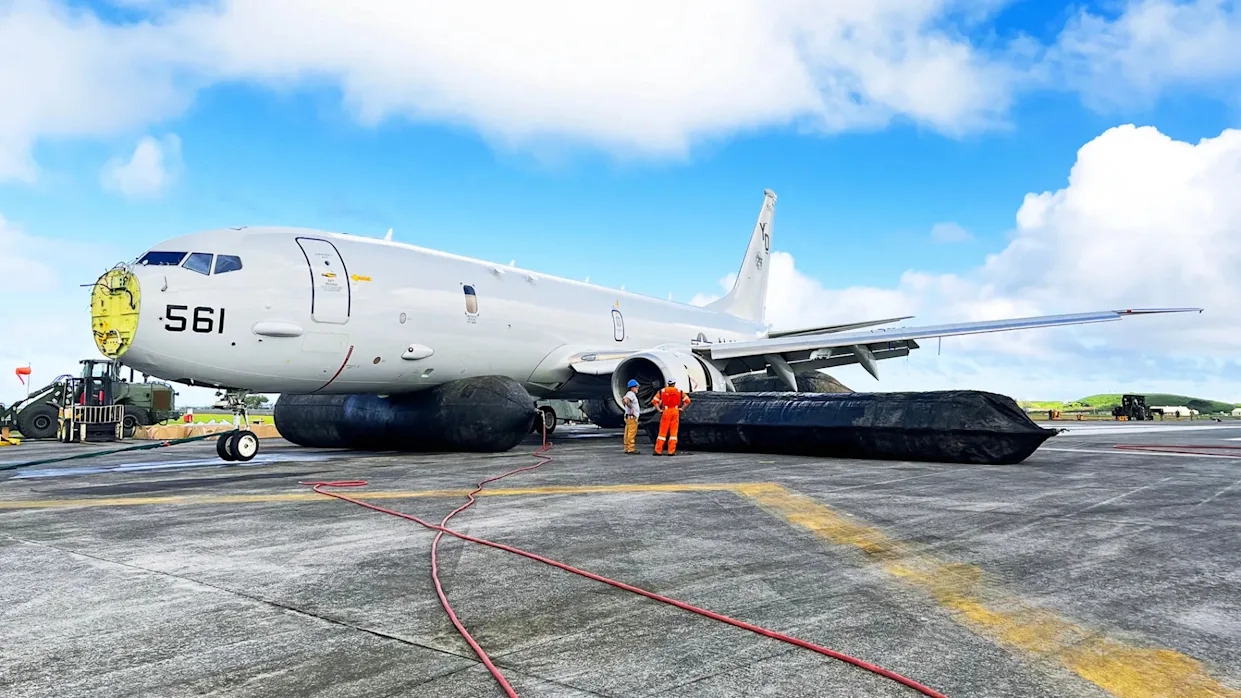
The U.S. Navy is scrapping a P-8A Poseidon that ended up in Hawaii’s Kaneohe Bay back in 2023, marking the first total loss of one of these aircraft. The service was initially hopeful that the plane could be returned to service, but ultimately decided it would be too costly to do so.
The P-8A in question ran off the runway at Marine Corps Air Station Kaneohe Bay, part of Marine Corps Base Hawaii, on November 20, 2023. All nine members of the crew were uninjured in the mishap and were able to return to shore. The aircraft, which was assigned to Patrol Squadron Four (VP-4) at the time, suffered significant damage, which was further compounded by the roughly two weeks it spent sitting in saltwater. A complex retrieval operation was executed to get the aircraft back on land, as you can read more about here. At the time of writing, the results of any investigation into the incident do not appear to be publicly available.
“The Navy’s P-8A Fleet Support Team, Boeing (P-8A Original Equipment Manufacturer), and AAR (P-8A Airframe Maintenance Repair and Overhaul provider) conducted a comprehensive airworthiness, engineering, and repair assessment of the aircraft structure and systems,” a spokesperson for Naval Air Systems Command (NAVAIR) told TWZ in a statement today. “As a result of the extensive repair requirements, necessity for unique aircraft manufacturing representative support equipment, and estimated cost required to return the aircraft to service in a mission capable configuration, pursuing a repair of the aircraft was determined to be cost prohibitive.”
The P-8A that crashed into the sea in 2023 has been written off and dismantled.https://t.co/PpkVGaPBkE https://t.co/yODI8tLQ6y pic.twitter.com/URSMCZLmpn
— 笑脸男人 (@lfx160219) July 23, 2025
The first sign that the P-8A was being scrapped came in the form of the video seen above, which first began circulating on social media last week.
“Following a formal aircraft strike authorization, the Navy proceeded with demilitarization and disposal of the P-8A aircraft involved in the 2023 mishap,” the NAVAIR spokesperson added. “Those activities are currently in progress in Hawaii and expected to be complete by August 2025.”

“In order to salvage all usable equipment from the aircraft prior to disposal, the Navy identified and removed all serviceable aircraft components and mission systems, transferring those parts to the Navy’s supply system for repair to logistically support other fleet aircraft,” the NAVAIR spokesperson further told TWZ.
What it might have cost to return the P-8A to service is unknown, but the Navy told the AP that the price tag on the salvage operation alone might total $1.5 million back in December 2023. As TWZ previously wrote after the jet had been extracted from Kaneohe Bay:
“The Navy is hopeful that the P-8A will be able to eventually return to service, but the full extent of the damage to the jet remains unclear. Salt water, which the jet was sitting in for around two weeks, can cause serious damage through corrosion. The aircraft’s engines were largely submerged the entire time, which could have led to major damage to fan blades and other internal components. The underside of the Poseidon is also lined with antennas and apertures, and it is unclear how much water may have seeped into the weapons bay or other spaces inside the aircraft. The jet’s nose cone, and the radar behind it, are also missing and it is not clear what the condition of those components might be now.”
“There is clearly an interest on the part of the Navy in making this P-8A operational again. Each one of these jets, which are based on the Boeing 737 Next Generation airliner, costs just over $171 million, according to Navy budget documents. So repairing even a seriously damaged example could be cheaper than buying a brand-new one.”
The P-8A unit price subsequently rose to nearly $180 million in Fiscal Year 2024, according to more recent Navy budget documents. The Navy expects to continue taking deliveries of new Poseidons into 2027, but there is no indication at present that it is planning to acquire an additional airframe to make up for the loss. The target total fleet size had previously been 128 airframes. The P-8A has now all but replaced the P-3C Orion maritime patrol plane, as well as the EP-3E Aries II intelligence, surveillance, and reconnaissance (ISR) aircraft.

Though generally described as a maritime patrol platform, the P-8A is really multi-mission with extensive ISR capabilities. The Navy is investing heavily in further expanding the capabilities of these aircraft with new munitions, podded self-protection systems, and other improvements. In June, the service took delivery of the first Poseidon with a major new upgrade package, referred to as Increment 3 Block 2. This includes “a new combat systems suite with improved computer processing, higher security architecture, a wide band satellite communication system, an ASW signals intelligence capability, a track management system, and additional communications and acoustics systems to enhance search, detection, and targeting capabilities,” according to the Navy.

Manufacturer Boeing has also seen significant success with the P-8 on the export market, with additional Poseidons in service now in Australia, India, New Zealand, Norway, South Korea, and the United Kingdom. Canada and Germany also have jets on order.
The Procurement Agency for the German Armed Forces (BAAINBw) and the German Navy stopped by the #P8 finishing center to check on the progress of their first P-8A Poseidon. Hear why the service says it'll be an "awesome feeling" to receive the first sub hunter later this year. pic.twitter.com/w3tyGpn3GA
— Boeing Defense (@BoeingDefense) July 15, 2025
The Navy’s P-8A fleet looks set for a long career, despite the service’s final decision to write off the waterlogged P-8A in Hawaii.
Contact the author: [email protected]






Comments